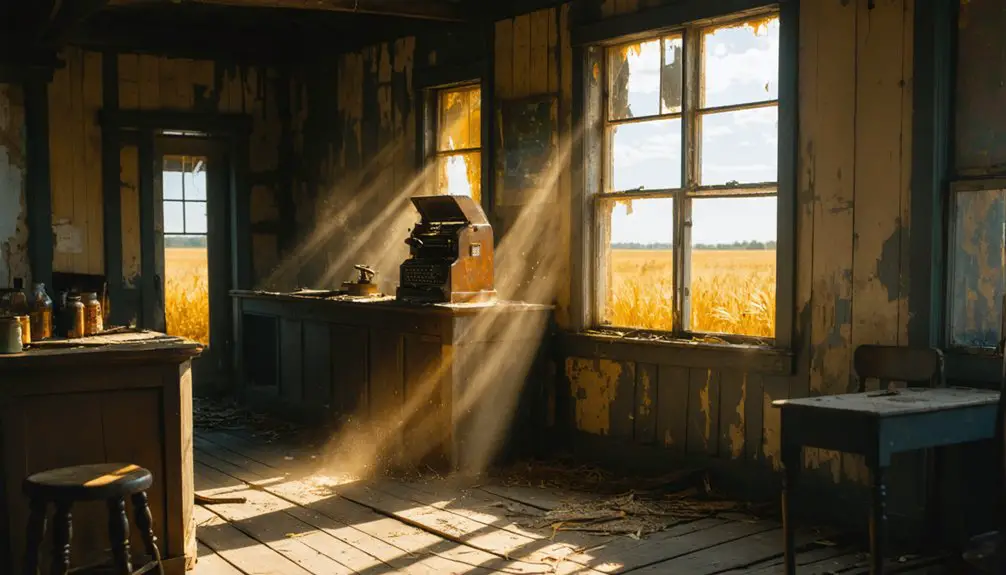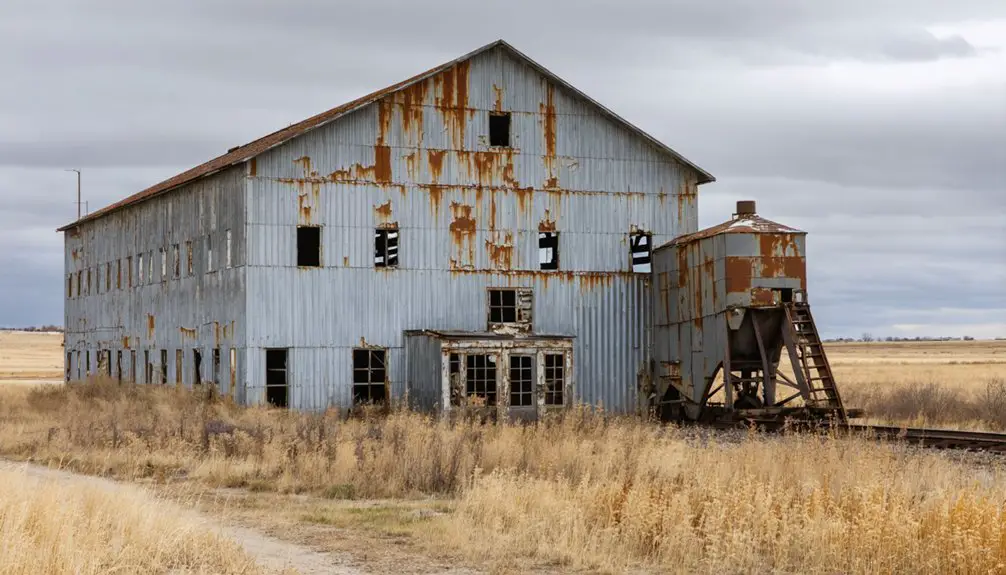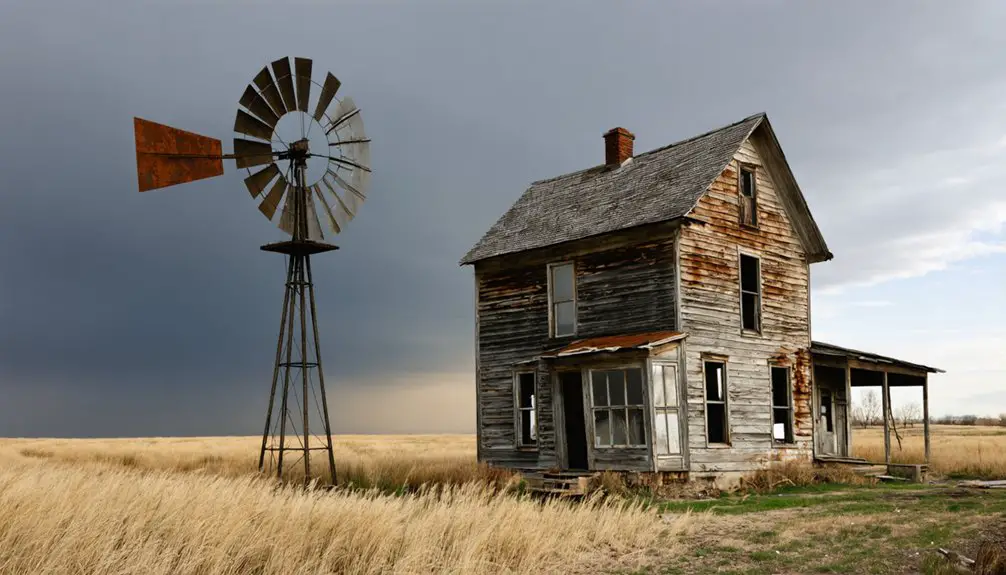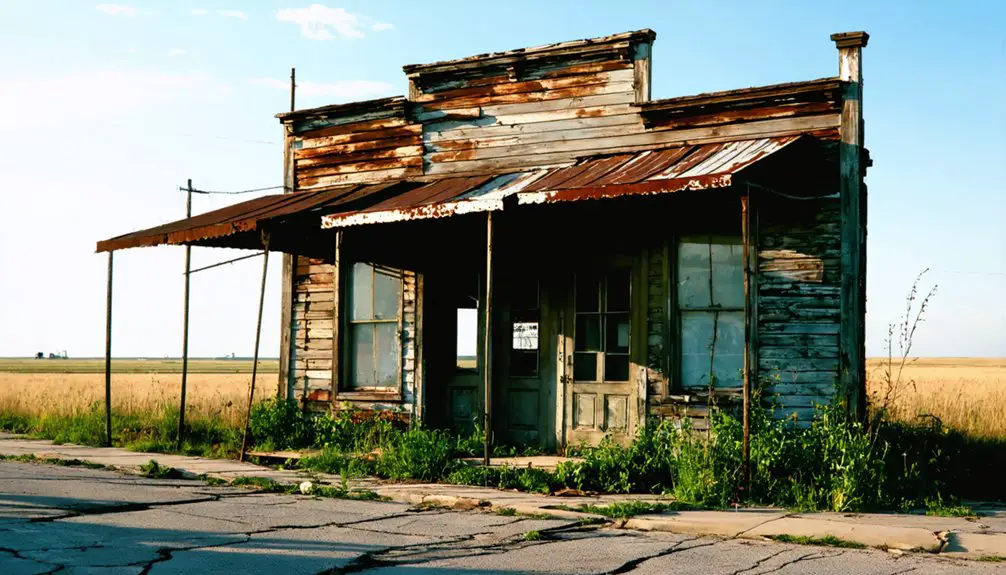You’ll find the ghost town of Omadi along Nebraska’s Missouri River, where ambitious settlers established a promising frontier community in 1856. The town quickly grew to include 40 frame houses, sawmills, a lumberyard, and a bustling newspaper. Despite its early success as a river trading hub with a population of 400, relentless flooding and erosion forced residents to abandon their dreams, leaving only the cemetery to tell its dramatic tale of frontier ambition and nature’s power.
Key Takeaways
- Omadi was a promising Nebraska Territory settlement established in 1856 along the Missouri River with 400 initial residents.
- The town featured impressive infrastructure including 40 frame houses, two sawmills, and an 8,000-foot building complex.
- Natural erosion of the Missouri River’s bank began in 1858, undermining buildings and forcing residents to relocate.
- By 1860, the population dropped dramatically from 400 to 46 residents due to flooding and soil erosion.
- The town’s cemetery remains the only physical remnant, as Omadi eventually disappeared beneath the Missouri River’s waters.
A Frontier Settlement Takes Root
As the newly formed Nebraska Territory beckoned settlers westward in 1856, the ambitious town of Omadi took root along the Missouri River in Dakota County. You’d have found a settlement bursting with frontier ambitions, quickly establishing itself with two sawmills, the region’s first lumberyard, and bustling docks serviced by St. Louis steamers.
Within its first year, Omadi’s social infrastructure began taking shape. The territorial legislature incorporated the town, while residents established a post office and launched the *Omadi Enterprise* newspaper. Like many early Nebraska settlers who faced systemic barriers, the town’s inhabitants struggled to establish permanent land ownership.
The town’s founders envisioned Omadi becoming the “queen city” of the West, though their dreams would ultimately remain unfulfilled.
Life Along the Missouri River
You’d find Omadi’s early residents making full use of the Missouri River’s commercial potential through ferrying operations, lumber trading, and merchant services catering to westward travelers.
Daily life centered around the riverbank where settlers gathered to fish, collect water, and coordinate trade with passing steamboats. Like other settlements along the Missouri River during the 1850s, the town saw increased activity as Native American tribes gradually moved westward.
The unpredictable Missouri River posed constant challenges, as seasonal flooding threatened crops and buildings, forcing residents to adapt their farming and construction practices to the river’s moods. Peter Sarpy operated the only ferry crossing in the area before pioneers began building their own ferry systems.
River Trade and Commerce
Life along the Missouri River flourished through a complex network of trading posts that shaped Nebraska’s early commerce and cultural exchanges. You’d find bustling posts like Fort Charles, Fontenelle’s, and Bordeaux’s where river trade thrived between Native Americans and Euro-American merchants.
These strategic locations served as essential economic exchanges, where tribes would trade valuable furs and buffalo robes for manufactured goods like metal tools, guns, and glass beads. Belgian-made guns were specifically manufactured to meet the exacting standards of Native American traders. Notable trader Manuel Lisa established Fort Lisa in 1812 as one of the most important trading centers along the Missouri.
The arrival of steamboats in the 1830s transformed commerce by drastically reducing shipping costs. You could witness massive quantities of corn, livestock, and other agricultural products moving through river towns, while warehouses stored goods awaiting transport to eastern markets.
These trading posts weren’t just commercial centers – they became cultural hubs where diverse communities gathered, fostering lasting relationships between traders and tribal nations.
Daily Riverside Activities
While the Missouri River served as an essential commercial artery, it also provided countless recreational opportunities for riverside residents.
You’d find locals spending their days fishing for catfish and sauger, while others enjoyed canoeing and kayaking in the calm backwaters. The river’s edge became a natural gathering spot for community gatherings and social events.
River recreation wasn’t limited to warm months. In winter, you could participate in ice fishing or cross-country skiing along groomed trails. Modern visitors can still explore 2.5 miles of trails along similar historic pathways.
Throughout the year, the riverbanks offered prime spots for birdwatching, especially during spring and fall migrations. Traditional activities like washing clothes and collecting water brought people to the riverside daily, making the Missouri River an integral part of both work and leisure in Omadi’s vibrant community life.
Flooding and Environmental Challenges
The Missouri River’s peaceful moments along Omadi’s shores often gave way to nature’s destructive power.
If you’d lived in Omadi during the late 1800s, you’d have witnessed the river’s unforgiving flood history firsthand, particularly during the devastating 1881 flood that raised water levels by 35 feet near Yankton. During this time, residents without elevated homes were forced to retreat to higher ground shelter. You would’ve seen fertile farmlands transform into vast inland seas, with homes and buildings becoming temporary islands.
The environmental impact of these recurring floods reshaped both the landscape and community life. The total damage from flooding reached over $2 billion in 2011 alone.
Despite later attempts to control the river through dams and levees in the 1960s, the Missouri remained a formidable force.
Even with modern flood control infrastructure, you’ll find that the river continues to challenge human engineering, as demonstrated by the 2011 flood that threatened the Gavins Point Dam system.
Commerce and Early Industry
You’ll find that Omadi’s bustling commerce centered on its strategic location along the Missouri River, where steamboats from St. Louis regularly unloaded cargo at the town’s docking facilities.
The establishment of the first lumberyard on the upper Missouri River, along with two sawmills, made Omadi a crucial hub for the timber trade in Dakota County. Steamboat traffic increased dramatically in the 1840s, transforming river towns into vital transportation hubs.
Local manufacturing enterprises included brick production and warehousing operations, while the presence of general stores and freight businesses helped establish Omadi as a promising commercial center in the 1850s.
River Trade Impact
Situated strategically at the confluence of Omaha Creek and the Missouri River, Omadi emerged as an essential commercial hub during the mid-1850s, capitalizing on its prime location for river trade. The town’s dynamic trade patterns revolved around steamers arriving from St. Louis, transforming Omadi into a significant river transportation gateway for western expansion.
- You’d find up to 15 steamers docked simultaneously, handling cargo bound for mining regions and frontier forts.
- The town’s first-of-its-kind lumberyard and two sawmills supported regional construction needs.
- River commerce created a vibrant social scene where teamsters, boat crews, and traders exchanged news and stories.
This bustling river port symbolized progress and opportunity, facilitating the movement of supplies, immigrants, and freight through Nebraska Territory‘s promising frontier landscape.
Early Manufacturing Enterprises
During its brief but vibrant period of growth, Omadi emerged as a manufacturing powerhouse along the upper Missouri River, anchored by its pioneering lumberyard and dual sawmill operations.
You’ll find that lumber production formed the backbone of local industry, with steam technology driving one of the mills and showcasing the town’s early adoption of industrial innovation.
Beyond timber, the town’s manufacturing sector diversified through pottery works that produced goods for export.
Several thousand bricks stored in town demonstrated Omadi’s readiness for expansion, while warehouses and storehouses supported a robust supply chain.
The town’s strategic position allowed manufacturers to receive raw materials and ship finished products via steamboat, though this advantage would later diminish as railroads became the preferred mode of transport.
The Heartbeat of a Growing Community

As pioneers carved out new lives along the Missouri River in 1856, Omadi emerged as a vibrant symbol of frontier ambition and community spirit.
You’ll find early infrastructure that reflected their bold community aspirations: the region’s first lumberyard, two sawmills, and a schoolhouse that served as both an educational center and gathering place.
- A bustling post office established in 1857 connected settlers to the outside world
- The Omadi Enterprise newspaper kept residents informed of local happenings
- Regular steamboat traffic from St. Louis brought essential supplies and trade opportunities
Natural Forces and Environmental Challenges
While Omadi’s early settlers built their dreams along the Missouri River’s edge, they couldn’t have anticipated the devastating natural forces that would ultimately seal their town’s fate.
Beginning in 1858, natural erosion of the Missouri’s left bank steadily undermined building foundations, forcing residents to relocate their homes or risk losing them to the river’s relentless advance.
The town’s environmental vulnerability became starkly apparent as the population plummeted from 400 to just 46 residents by 1860.
Flooding and soil erosion accelerated the town’s demise, with the river completely consuming the original townsite by 1865.
You’ll find no trace of the original settlement today – Omadi joined its rival town Logan beneath the waters of the ever-changing Missouri River.
The Rise and Fall of Economic Dreams

From its ambitious 1856 founding, Omadi embodied the economic dreams of frontier entrepreneurs seeking to establish a thriving Missouri River trade hub.
You’ll find that Omadi’s ambitions were backed by impressive early infrastructure – the first lumberyard on the upper Missouri, two sawmills, and a newspaper, all fueling hopes of becoming Dakota County’s seat.
- Steamboats regularly docked, connecting trade with St. Louis
- 40 frame houses and an 8,000-foot building complex showcased rapid growth
- Active freighting operations equipped settlers heading west
The town’s economic aspirations crashed during the 1857 financial panic, as unstable banks closed and real estate values plummeted.
Competition from larger river towns like Omaha, which handled hundreds of steamboats yearly, further weakened Omadi’s position.
The promising frontier port ultimately couldn’t sustain its early momentum against these mounting challenges.
Stories From the Omadi Enterprise
During its brief but significant run from 1857 to 1858, the Omadi Enterprise captured the pulse of Dakota County‘s first frontier settlement. Under George Rust’s editorship, this pioneering local newspaper chronicled the town’s ambitious vision of becoming a thriving Missouri River port.
You’ll find the Enterprise’s pages filled with stories of community milestones – the opening of the post office, the rise of sawmills and lumberyards, and the construction of the schoolhouse.
Through its role as the central hub of community communication, the newspaper connected settlers and promoted local businesses essential to Omadi’s development.
As Omadi’s vital communication center, the Enterprise wove together pioneer lives while championing the businesses that built the frontier town.
While the paper’s lifespan was short, matching the town’s eventual fate, its historical documentation provides a window into the spirit of frontier journalism and the dreams of early Nebraska Territory pioneers.
Traces of a Lost Nebraska Town
Today, if you visit the former site of Omadi, Nebraska, you’ll find little evidence of this once-promising frontier settlement beyond its historic cemetery.
The lost architecture of this ambitious river port town, which once boasted 40 houses and various commercial buildings, now lies beneath the shifting waters of the Missouri River. The historical significance of Omadi’s story serves as a powerful reminder of nature’s impact on frontier settlements.
- By 1865, river erosion had completely consumed the town’s buildings, docks, and warehouses.
- Bricks from Omadi’s structures were salvaged and repurposed in nearby construction projects.
- The cemetery remains as the last tangible connection to this early Nebraska settlement, preserving the memory of its pioneering residents.
Lessons From a Vanished Settlement
The rise and fall of Omadi offers powerful insights into frontier settlement dynamics and the perils of unchecked ambition.
You’ll find that this once-promising Missouri River town fell victim to classic settlement patterns that doomed many frontier communities: overreliance on speculative investments, vulnerability to economic bubbles, and failure to establish economic sustainability.
When you examine Omadi’s story, you’ll see how its rapid development – including a newspaper, sawmills, and ambitious brick construction – couldn’t withstand the triple threat of the 1857 Panic, the Pike’s Peak Gold Rush exodus, and the river’s erosion.
The town’s collapse teaches us that successful settlements need diversified economies, stable populations, and careful consideration of environmental risks.
Omadi’s remnants remind you that frontier dreams required more than optimism to survive.
Frequently Asked Questions
What Indigenous Peoples Inhabited the Omadi Area Before European Settlement?
You’ll find the Omaha Nation as the primary Native Tribes in this region, with cultural significance tied to their Missouri River settlements and earth lodge communities they established before European contact.
Were There Any Notable Crimes or Lawlessness in Omadi’s Short History?
You won’t find documented criminal activity in historical records from this period. Despite minimal law enforcement presence, the small trading community appears to have maintained basic order without notable lawlessness.
Did Any Famous Pioneers or Historical Figures Visit Omadi?
Despite forty buildings standing in 1860, you won’t find any famous visitors or pioneer stories in historical records. Local figures like newspaper editor George Rust were the only notable residents.
What Happened to the Residents After Omadi’s Abandonment?
You’ll find that residents’ relocation happened in waves – some joined the Pike’s Peak Gold Rush, others moved to Dakota City, and many scattered across Nebraska’s river towns due to economic impacts.
Were There Any Documented Paranormal Experiences in Omadi’s Ruins?
You won’t find documented ghost sightings or eerie encounters in these ruins – despite the region’s rich paranormal history, there’s no credible evidence of supernatural activity at this specific location.
References
- https://history.nebraska.gov/publications_section/omadi/
- https://history.nebraska.gov/tag/omadi/
- https://www.instagram.com/p/CxIzQYiOht9/
- https://www.youtube.com/watch?v=redtU6GT-BY
- https://kids.kiddle.co/List_of_ghost_towns_in_Nebraska
- https://www.nps.gov/subjects/travelomaha/growth.htm
- https://nebraskalegislature.gov/pdf/bluebook/2008/60-69.pdf
- https://www.nebraskalife.com/blog/post/frontier-matriarchs
- https://history.nebraska.gov/wp-content/uploads/2017/12/doc_publications_NH1961MissouriRFrontier.pdf
- https://www.britannica.com/place/Nebraska-state/History



